JAPH Back Issues
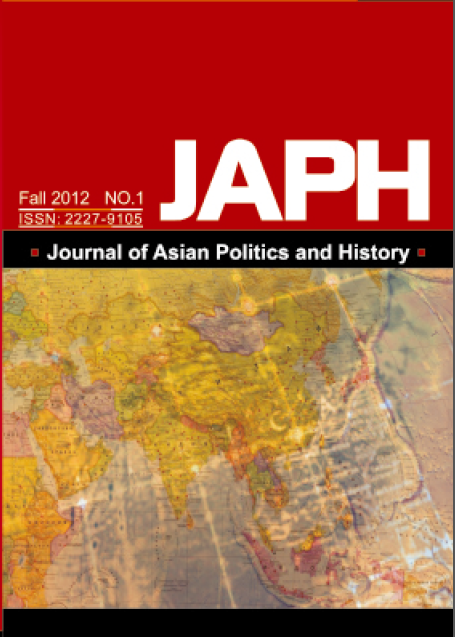
JAPH Fall 2012 Issue (No. 1)
Chief Editor
David Ho, Clarewood Institute, Hong Kong/USA
Senior Editor
William Case, City University of Hong Kong, HK
Book Review Editor
George Kallander, Syracuse University, USA
Manuscript Editors
Oleg Benesch, University of London, UK
Niclas D. Weimar, Cologne University, Germany
Nicole Velasco, Lee University, USA
Submission Editors
Tomohiko Kawaguchi, Nihon University, Japan
Choon H. Choi, Korea Institute for National
Unification, South Korea
Dongjin Chen, Kent State University, USA
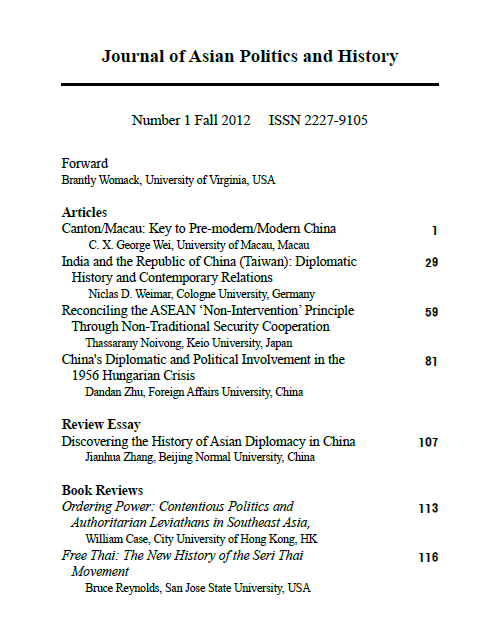
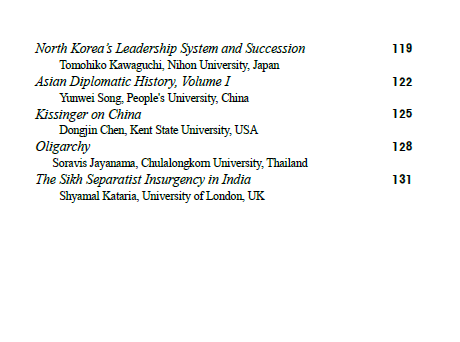
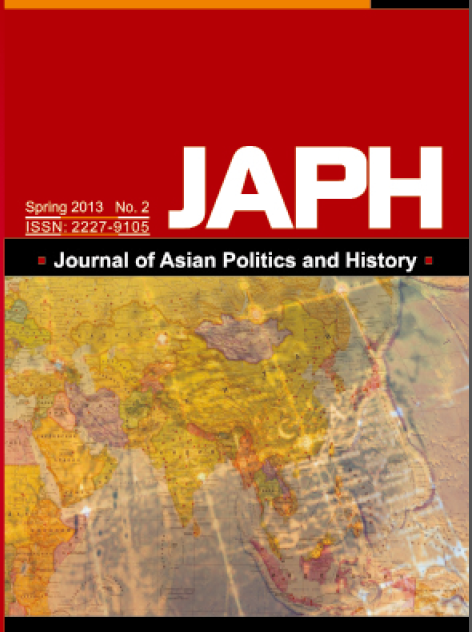
JAPH Spring 2013 Issue (No. 2)
Editor in Chief
David Zhigong Ho, Clarewood Institute, USA
Senior Editor
William Case, City University of Hong Kong
Book Review Editor
George Kallander, Syracuse University, USA
Manuscript Editors
Oleg Benesch, University of London, UK
Niclas D. Weimar, Cologne University, Germany
Nicole Velasco, Lee University, USA
Associate Editors
Tomohiko Kawaguchi, Nihon University, Japan
Choon H. Choi, Korea Institute for National Unification
Dongjin Chen, Zhejiang University, China
Albert Park, Claremount McKenna College, USA
Se-mi Oh, University of Wisconsin, USA
Jisoo Kim, George Washington University, USA
Assistant Editors
Cedar Bough Saeji, UCLA, USA
Erik French, Syracuse University, USA
Xiaoxia Lei, Clarewood College, Macau
Fang Wang, Xiamen University, China
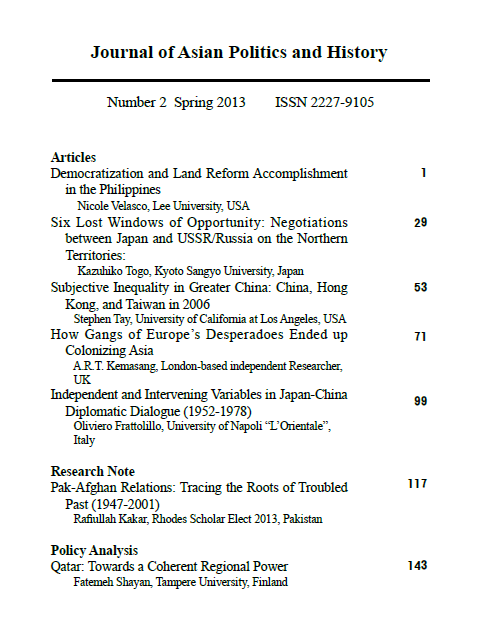
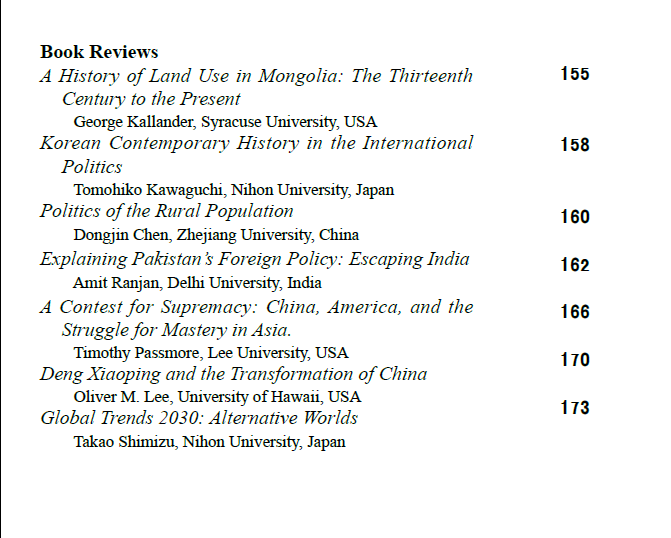
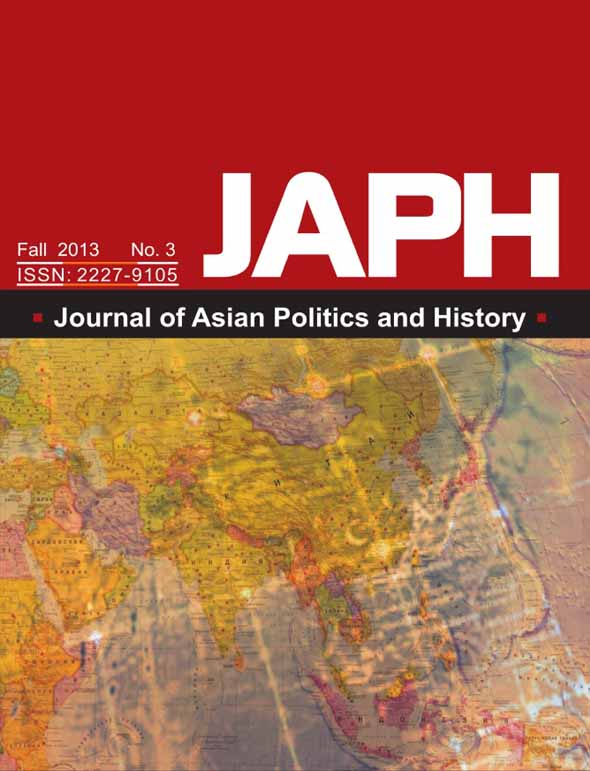
JAPH Fall 2013 Issue (No. 3)
Editor in Chief
David Zhigong Ho, Clarewood Institute, USA
Senior Editor
William Case, City University of Hong Kong
Book Review Editor
George Kallander, Syracuse University, USA
Manuscript Editors
Oleg Benesch, University of London, UK
Niclas D. Weimar, Cologne University, Germany
Nicole Velasco, Lee University, USA
Associate Editors
Tomohiko Kawaguchi, Nihon University, Japan
Dongjin Chen, Zhejiang University, China
Albert Park, Claremount McKenna College, USA
Se-mi Oh, University of Wisconsin, USA
Jisoo Kim, George Washington University, USA
Assistant Editors
Cedar Bough Saeji, UCLA, USA
Erik French, Syracuse University, USA
Xiaoxia Lei, Clarewood College, Macau
Fang Wang, Xiamen University, China
Jaclyn Clark, University of Washington, USA
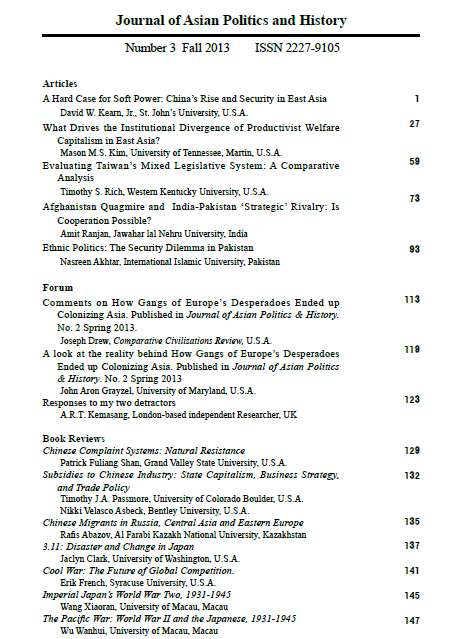
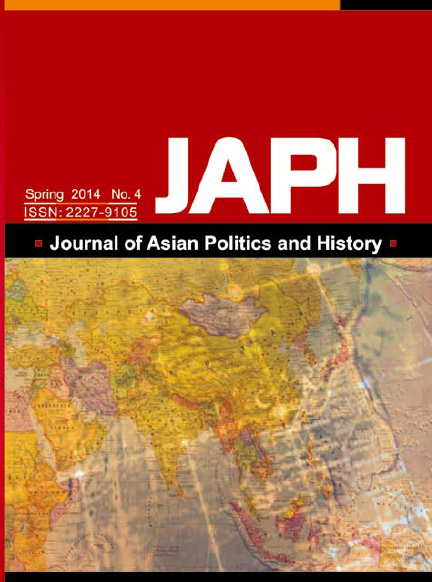
JAPH Spring 2014 Issue (No. 4)
Editor in Chief
David Zhigong Ho, Clarewood Institute, USA
Senior Editor
William Case, City University of Hong Kong
Book Review Editor
George Kallander, Syracuse University, USA
Manuscript Editors
Oleg Benesch, University of London, UK
Niclas D. Weimar, Cologne University, Germany
Nicole Velasco, Lee University, USA
Associate Editors
Tomohiko Kawaguchi, Nihon University, Japan
Dongjin Chen, Zhejiang University, China
Albert Park, Claremount McKenna College, USA
Se-mi Oh, University of Wisconsin, USA
Jisoo Kim, George Washington University, USA
CedarBough Saeji, Hankuk University of Foreign
Studies, South Korea
Assistant Editors
Erik French, Syracuse University, USA
Phillip Kaipeng Wang,Sun Yat-sen University,China
Jaclyn Clark, University of Washington, USA
Chloe He, Macau Clarewood College, Macau
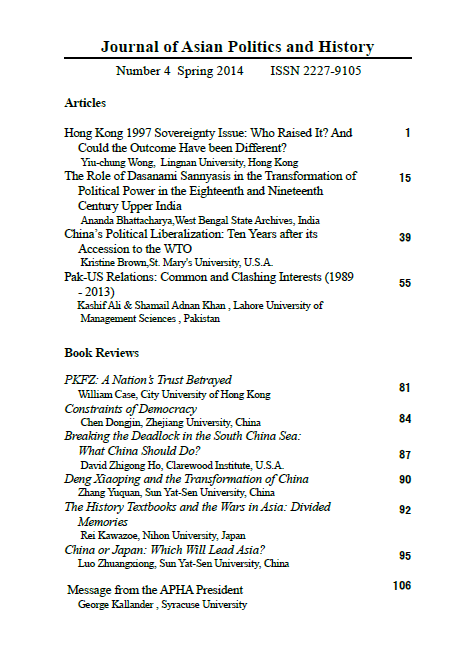
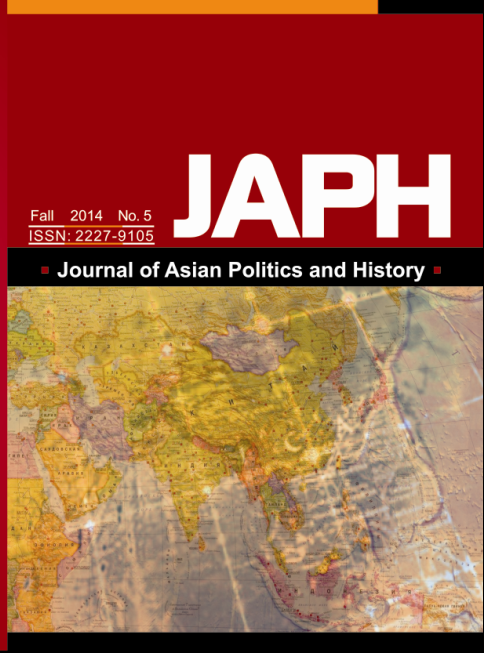
JAPH Fall 2014 Issue (No. 5)
Editors in Chief
David Zhigong Ho, Clarewood Institute, USA
Simon Shen, Chinese University of Hong Kong
Senior Editor
George Kallander, Syracuse University, USA
Book Review Editor
CedarBough Saeji, Hankuk University
of Foreign Studies, South Korea
Manuscript Editors
Oleg Benesch, University of London, UK
Niclas D. Weimar, Cologne University, Germany
Nicole Velasco, Lee University, USA
Peer Review Editor
Yiu-Chung Wong, Lingnan University, Hong Kong
Associate Editors
Tomohiko Kawaguchi, Nihon University, Japan
Dongjin Chen, Zhejiang University, China
Albert Park, Claremount McKenna College, USA
Se-mi Oh, University of Wisconsin, USA
Jisoo Kim, George Washington University, USA
Assistant Editors
Erik French, Syracuse University, USA
Phillip Kaipeng Wang,Sun Yat-sen University,China 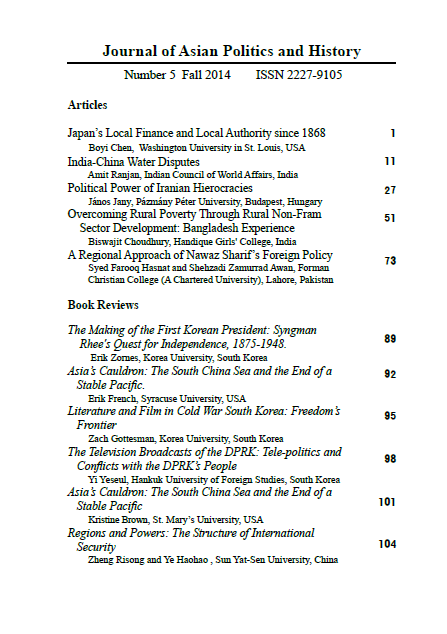
Jaclyn Clark, University of Washington, USA
Chloe He, Macau Clarewood College, Macau
JAPH Spring 2015 Issue (No. 6)
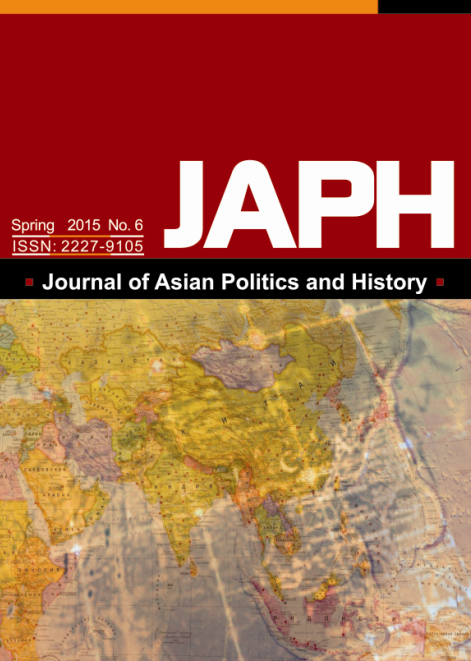
Editors in Chief
David Zhigong Ho, Clarewood Institute, USA
Simon Shen, Chinese University of Hong Kong
Senior Editor
George Kallander, Syracuse University, USA
Book Review Editor
CedarBough Saeji, Hankuk University
of Foreign Studies, South Korea
Manuscript Editors
Oleg Benesch, University of London, UK
Niclas D. Weimar, Cologne University, Germany
Nicole Velasco, Lee University, USA
Associate Editors
Dongjin Chen, Zhejiang University, China
Albert Park, Claremount McKenna College, USA
Se-mi Oh, University of Wisconsin, USA
Jisoo Kim, George Washington University, USA
Assistant Editors
Erik French, Syracuse University, USA
Bo Gao,University of Nottingham Ningbo China,
China
Jaclyn Clark, University of Washington, USA
Chloe He, The Clarewood Institute, USA
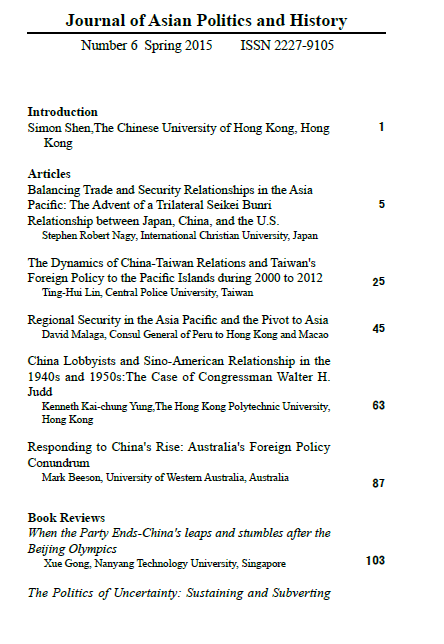
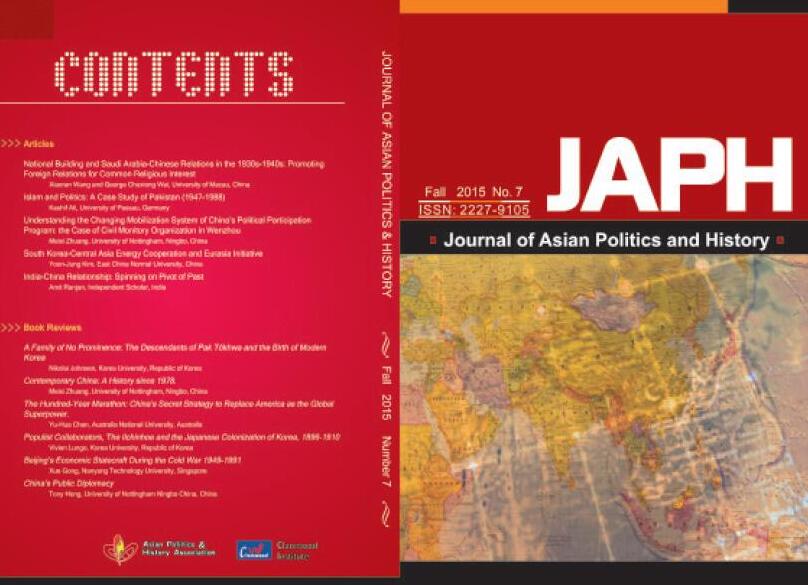
National Building and Saudi Arabia-Chinese
Relations in the 1930s-1940s: Promoting Foreign Relations for Common
Religious Interest
Xiaoran Wang and George Chuxiong Wei
University of Macau, China
Abstract
As the extending of influence in Middle East and the realizing of ��One Belt One Road�� plan, China has gotten great opportunities as well as challenges there. The Arab Spring in 2011, China��s negative labels in other regions, the ethnic problems, etc., have become barriers of diplomatic relationship between China and Middle East. While, historical experiences in the establishment of diplomatic relations of China and countries in Middle East, might help us to find a way out. This paper will present the process of relationship-establishment between
China under its leaders Sun Yat-sen and Chiang Kai-shek, and Saudi Arabia under King Abdul Aziz in the 1930s. At that time, it was the common goal for national building that paved the way for development of relationship between the two nations and that it was the religious force of Islam brought the two nations together. That might give inspiration to issues nowadays.
Key words: King Abdul Aziz, Sun Yat-sen, Chiang Kai-shek, Sino-Middle East relations, Muslims
The History of Communication between China and the Arabian Peninsula and the Influence of Islam in China
China and the Arab world have communicated with each other for long. At the year of Hegira (622 AD), it was the early Tang Dynasty of China. Chinese scholars generally agree that China established diplomatic contact with the Arab world in 651 AD (Melanie Jones-Leaning & Douglas Pratt 2012). Islam was introduced to China by Arab traders who also started the history of the Arab immigration into China. During the Song Dynasty(960-1279), the offshore transportation and commerce of China further developed. Arab traders began to conduct business with China via both sea and land route (John Chaffee 2006).They did not only live in China but also built mosques in their settlement.Therefore, Islam was further developed in China. The existing earliest mosque was built in 1009 in Quanzhou (Bai Shouyi 1983, 329). 1
During the Yuan Dynasty (1206-1368), some Arab immigrants worked in the government due to their ability of financial management (Bai Shouyi 1983, 173). They intermarried with Mongolians and Han people as the members of China��s urban residents, and had gradually integrated into Chinese people completely over generations, no longer foreigners living in China. Some of them even gave up Islamic practice, but meanwhile, more people of other beliefs became Muslims. The congregation of Chinese Muslims was growing (Ring Kwok 2007, 68-71).
How to evaluation the policy of the Chinese government toward Muslims during the Ming Dynasty (1368-1644) is still a controversial topic today, but it can be certain that there were a large number of Muslim officials working in the central government of Ming. Islamic culture also had a comprehensive development during that period (Jiang Xin 2010, 76, 79). With the development of transportation, more and more China-born Muslims hoped to pay a pilgrimage (the Hajj) to the Cradle of Islam. That desire of Chinese Muslims, thanked to the oversea exploration in the early Ming Dynasty, could be realized by joining the overseas expedition. For example, the famous explorer, Zheng He, had been able to make use the opportunity of leading overseas expeditions to attend ��Tian Fang��, which, according to historians, is Mecca, one of the holy sites in Saudi Arabia (Yan Mingshu 2007). When scholars analyzed the purpose of Zheng He��s voyage, they also found out that although Zheng He was appointed by the Emperor to lead the expeditions, the Hajj desire was also his important motivation (Yan Mingshu 2007, 85 -87& Liu Baofeng, 2012, 68-71). According to the collected source materials, Zheng He was born in a Chinese Muslim family named ��Ma��, which was registered at Kunyang Zhou, Yunnan Province for generations. His grandfather was given the name Yan, and grandmother was from Ma family. His father was Hazhi, and mother was from Wen family�� (Zhongguo Hanghaishi Yanjiuhui, 1985 1). In China, ��Hazhi�� referred a Muslim who went to Mecca and who had great moral strength and enjoyed high reputation. Obviously, Zheng He��s father must have gone to Mecca so that he gained the title of ��Hazhi��.2 Influenced by his father and family, Zheng He yearned to Mecca since childhood, and he did achieve his dream.
During the Qing Dynasty, especially after the First Opium War (1842), Chinese people began to eagerly seek knowledge from the West in order to find the effective means to save the nation. Among all the knowledge sought from abroad were the stories and experiences of Muslim countries about their fighting against the colonialists for independence, which had been introduced by religious individuals and communities, politicians and overseas Chinese into China. For instance, in Record of the Pilgrimage Journey (Chaojin Tuji) (Ma Dexin, Ma Anli 1988),3 Ma Dexin introduced readers the information on Islamic countries. From this kind of readings, Chinese intellectuals and officials could learn the method of fighting western colonialists and for reform as well as western technology from the Islamic countries.
Thus, the long history of communication between China and the Arabian Peninsula had laid down a foundation for diplomatic development between the Republic of China and Saudi Arabia in 1930s and 1940s. In the modern time, both of the two ancient civilizations faced the challenges of national revival. Their similar experiences became the chance for establishing of diplomatic relations between them. The Muslims also took an important intermediary role in promoting this relationship.
The Exploration of the Path for the National Building of China and Saudi Arabia
The Revitalization and National Building of Saudi Arabia
The course to revitalize the central Arabian Peninsula by King Abdul Aziz started as early as 1900s (Captain C. C. Lewis 1933, 518). In January of 1902 the young King captured Riyadh and re-established Alsaud in Najd (Jacob Goldberg 1982, 22). He then displaced King Hussein from the Hejaz (F. W. Brecher, 1988, 45). And, finally established the Kingdom of Saudi Arabia in September, 1932 (Captain C. C.
Lewis 1933, 526). As building the Kingdom, King Abdul Aziz carried out a series of reform. Internally, he initiated the policies to reform and unify the administrative, judicial and Financial System of the state, to strengthen the administrative function of the central government, and to introduce advanced technology for developing transportation and communication. He also promoted education especially the modern education. Externally, he endeavored to promote foreign relations with neighbors as well as the big powers, with the hope to establish an equal relationship with all foreign countries. But he had to play a strategy of balancing power among big powers to maintain the space for national survival and development. There are some viewpoints that the process that King Abdul Aziz built Saudi Arabia was ��also a competition between differing concepts of state-craft.�� The building of the Kingdom was also the triumph of the King��s ��vision of Islamic and Arabian government�� (John Demetrios Sotos, 1982 36). It was believed that King Abdul Aziz aimed to build a modern Arabian state based on Islamic tradition, with an emphasis on the importance of Muslim to domestic affairs and diplomacy.
In the process of national unification, King Abdul Aziz took the principles of Sheikh Muhammad ibn Abd al-Wahhab's reform movement as a spiritual bond of the nation and emphasized the compatriot love between believers, in order to solve the problem of the tribal fiefdoms and to seek the formation of countries. To change the tradition of migrating among herdsmen, the King gave them lands to settle down and established mosques on those lands. Despite of the strong opposition from some religious quarters, the King suggested that any modern science and technology which did not conflict with Islamic spirit could be accepted even when there was no clear stipulation about that in the Koran (Wang Tiezheng 1989, 58). King Abdul Aziz once clearly stated that if the country continued the old way of raiding on pilgrims, employing harassment to travelers and denying passage to them (Bakor Omar Kashmeeri 1973, 114-115). When Ulama queried and challenged the reform, the King would either make a compromise or argue for the reform in accordance of the Islamic spirit (Wang Tong 2002, 70).
In area of diplomacy, King Abdul Aziz actively tried to improve Saudi Arabia��s relations with its neighbors Kuwait and Bahrain, to resolve problems with Egypt, Iraq and Transjordan, and to support Syria��s liberation movement. Saudi Arabia paid more attention to the role of Islam in diplomacy. When receipting pilgrims, the King friendly treated Muslim from other countries. Thus, the international status of Saudi Arabia was improved through Hajj (A. B. A. Haleem 2008, 91 & Wang Tiezheng 1989, 54-60).
For national survival and space for development, the King took the strategy of balancing power among big powers. To reduce the support of Britain to the Ottoman Turks, the King established diplomatic relations with Britain in order to break up the economic blockade against Saudi Arabia (Al-Zaydey, Hussien A. Mobarak 1989). Meanwhile, King Abdul Aziz tried to get rid of the British control. In 1927, the relatively equal treaty�� Treaty of Jeddah��was signed (1928, 22). In 1930s, Saudi Arabia established a trade relation with the United States, which relieved the pressures from domestic economy and foreign debts. The exploiting of oil resources
��provided Saudi Arabia with the economic base of modern power�� (Robert R.Sullivan 1970, 436).
Besides, King Abdul Aziz also tried to establish diplomatic relations with countries that sought for equal relationships. Of course, there were many countries having similar aspiration with that of Saudi Arabia, and the Republic of China was one of them. Moreover, China had some similar processes of revitalization with that of Saudi Arabia at that time.
Chinese Muslims and the National Building
In October of 1911, due to a series of internal and external crises, the Chinese revolutionaries launched another uprising, after many failures, in response to the call of the Sun Yat-sen. This time, they succeeded. The old empire of China fell, and the Republic of China was established.
China is a country of multi-ethnic-groups and religious beliefs. There was no uniform name for the super-state of China��every dynasty had its own name, though the nation of China is called ��Zhongguo��, the Middle Kingdom. As early as the Qing and Han dynasties, the ruling elites of China were already of diverse ethnic origins, In fact, the rulers of the Tang Dynasty were not pure ��Han people��(Chinese natives). Its founder,Emperor Gaozu,had a foreign mother hence only 50% of ��Han�� DNA. Its second ruler, Emperor Taizong, again had a foreign mother hence only 25% of ��Han��DNA.4 Then, during the Yuan/Mongol Dynasty, and Qing/Manchu Dynasty, it was the non-Han ruling family that presided over the Chinese super-state. It was during the time of the so-called �� wu Hu luan Hua�� (five foreign races creating chaos on the land of China) that the foreign conquerors were stigmatized as ��Hu�� (foreigner) and the subjugated native people calling themselves ��Han����a nostalgic expression of the ��Paradise Lost�� memorial of the Han Dynasty. There was no proper name for number of people to the battlefield, from common
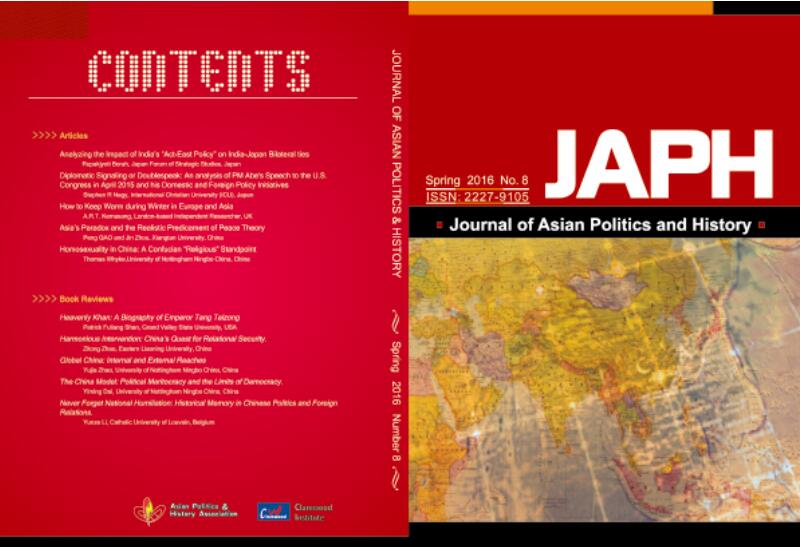
Analyzing the Impact of India��s ��Act-East Policy�� on India-Japan Bilateral Ties
Rupakjyoti Borah
Japan Forum of Strategic Studies,Japan
Abstract
In spite of the historical ties between Japan and India, which date back to the times when the Indian monk, Bodhisena visited Japan, New Delhi and Tokyo, stood on opposite sides of the divide during the Cold War era. It was only in the aftermath of the end of the Cold War and the launch of India��s economic liberalisation programme that the relations between the two countries actually took off. This was also the period when India launched its ��Look-East Policy�� (now renamed as ��Act-East Policy��)
This paper will argue that India��s ��Act-East Policy�� has been pivotal in putting India-Japan relations on the fast-track. It will also look at the US factor in the ties as India��s growing closeness to the US has helped to bring India and Japan closer, as Japan has been a steadfast US ally. This study will look at Japan-India ties through the realist prism. It will elucidate the areas of cooperation and divergence between the two countries and finally draw up a roadmap for the future of the ties.
Keywords: India, Japan, Act-East Policy, Look-East Policy, Indo-Pacific
Japan-India Relations during the Cold War Era
In the period after India��s independence in 1947, most of the historical goodwill dissipated as India became a staunch advocate of non-alignment (though it inched closer to the erstwhile Soviet Union) while at the same time, Japan became an ally of the United States. However, it is important to note here that India refused to attend the San Francisco Conference and signed a separate peace treaty with Japan later and also waived off any reparations claims from Japan.
The first Indian PM Jawaharlal Nehru gifted an elephant to Japan in 1949 which lifted the spirits of the Japanese people in the dreary days following the devastation of the Second World War. Indian iron-ore played a key role in the recovery of Japan after the devastation that was wrought on it. Nobusuke Kishi became the first Japanese PM to visit India in 1957 (Borah: 2012) while India became the first recipient of yen loans given by Japan.
Slowly but surely, India began to inch closer to the erstwhile Soviet Union. India��s Five-Year Plans were modelled on the Soviet pattern. In 1971, India signed a Treatyof Peace, Friendship and Cooperation with the erstwhile Soviet Union. This was before the India-Pakistan war later that year which led to the creation of Bangladesh. There was not much of economic relations between Japan and India either as India followed a closer-door socialist economy while Japan marched ahead economically as a capitalist economy. India��s refusal to criticize the Soviet Union for its invasion of Afghanistan and its support for the Heng Samrin regime in Cambodia further distanced it from Japan. During the Cold War, India��s relations with the United States were also strained on account of India��s closeness to the Soviet Union and the Americans�� proximity with Pakistan. During the Cold War era, high-level contacts between India and Japan were few and far between. The then Japanese PM Hayato Ikeda paid a visit to India in 1961 and there was long gap of 23 years before the next Japanese PM Yasuhiro Nakasone visited India in 1984.
Things began to change when the Japanese auto-maker Suzuki entered the Indian market and became a runaway success when it teamed up with the Indian government to launch cars under the Maruti Suzuki brand name. Till that time, Indian customers had very few options when it came to cars.
Japan-India Relations after India��s ��Act-East�� Policy
India��s ��Act -East Policy�� was launched in the early 1990��s following the dissolution of the erstwhile Soviet Union and the severe balance of payments crisis faced by India. It was under the then Prime Minister Narasimha Rao and his Finance Minister Dr Manmohan Singh (who later went to become the Prime Minister of India), that India decided to liberalize its economy following decades of sluggishness. It was at the same time that the �� Act-East Policy�� was also launched which aimed at re-engaging the countries of East Asia and Southeast Asia, as India already had historical ties with countries in these regions. For example, the state philosophy of Indonesia, ��Pancasila�� draws from the Sanskrit words Panca(meaning five) and Sila(meaning principles). The island of Java in Indonesia (which is the world��s largest Muslim country by population) is still predominantly Hindu. Then there are cultural relics like the Angkor Wat temple complex in Cambodia, which started out as a Hindu temple (though it is now a Buddhist temple). Similar has been the case with East Asian countries including Japan.
However, the relations received a big jolt in the wake of India��s nuclear tests in 1998. Japan reacted very strongly to these tests as it is the only country to have suffered from the impact of atomic weapons, which were dropped on Hiroshima and Nagasaki during the Second World War. New Delhi��s refusal to sign the CTBT and the NPT has also irked Tokyo. In response to India��s nuclear tests, Japan had asked India to stop nuclear testing and development of nuclear weapons while yen loans to India for new projects were frozen. It was not until the visit of the then Japanese Prime Minister Yoshiro Mori to India in 2000 that the relations rebounded again. During that visit, the two countries started the ��Japan-India Global Partnership in the 21st century��. It was during the visit of the former Japanese Prime Minister Junichiro Koizumi to India in April 2005 when it was decided to have annual summits at thePrime Ministerial level. Since then, the two Prime Ministers have been meeting alternatively in Tokyo and New Delhi. During the visit of the then Indian PM Manmohan Singh to Japan in December 2006, the relations were upgraded to a ��Global and Strategic Partnership��
It is worth noting here that the maximum chunk of Japanese ODA(Official Development Assistance) has been coming to India since 2003-2004 and ODA levels have not fallen even after the Great East Japan Earthquake of March 2011.
During PM Abe��s visit to India in August 2007 when he was Prime Minister for the first time, Abe noted the immense potential of the Japan-India bilateral relationship. In a landmark speech titled ��Confluence of the Two Seas�� delivered before the Indian Parliament, PM Abe noted that ��Japan has undergone "The Discovery of India", by which I mean we have rediscovered India as a partner that shares the same values and interests and also as a friend that will work alongside us to enrich the seas of freedom and prosperity, which will be open and transparent to all.��(Abe: 2007)
In the year 2008, Japan and India signed a landmark security treaty, the likes of which Japan has signed only with Australia. The relations have seen an upward spike ever since the election of Shinzo Abe as the Prime Minister for second term in December 2012. In late 2013, the Japanese Emperor and Empress visited India in a momentous visit as it is rare for the Japanese monarchy to travel abroad. In 2014, Prime Minister Shinzo Abe was the Chief Guest at India��s Republic Day, an honour which is reserved for India��s close friends.
The close personal rapport between the Indian PM Narendra Modi and his Japanese counterpart Shinzo Abe has also helped in the growth of the bilateral ties. Interestingly, PM Narendra Modi is one of the 11 people PM Shinzo Abe follows on the social media platform, Twitter. During PM Modi��s visit to Japan, Abe went out of protocol to personally welcome him in Kyoto. During the visit, an agreement was signed for cooperation between the former historical capital of Kyoto with the Indian ancient city of Varanasi, which also happens to be PM Modi��s Parliamentary constituency, in the fields of heritage conservation, modernisation, art and culture.
Japan and India relations have seen a deep improvement after PM Modi took office in India. Japan was the first country, outside the immediate neighbourhood (Bhutan and Nepal) to be visited by PM Modi. During this trip, Japan pledged approximately $35 billion in India��s infrastructure sector. During this visit, PM Modi also assured that he would set up a special cell in the PMO (Prime Minister��s Office) to speed up clearances for Japanese projects in India. He had visited Japan earlier while he was the Chief Minister of the Indian state (province) of Gujarat and had been successful in getting Japanese companies to invest in Gujarat.
Areas of Convergence
There are a series of factors which are bringing Japan and India closer.
Firstly, India as a developing country, faces a shortage of capital and infrastructure while Japan is already a developed country with high-end technology. This has created a big synergy between Japan and India in the economic realm. Japan has provided both loans and technology for many major infrastructure projects in India like the Delhi-Mumbai Industrial Corridor (DMIC), the Delhi Metro, the Chennai-Bangalore Industrial Corridor (among others). On the other side, India represents a huge market for Japanese companies; especially they have been facing problems in China due to political differences between Japan and China. In addition, India has a growing middle-class which is getting richer, creating a huge market for Japanese companies which are facing increasing competition from Chinese and Korean firms abroad and a falling population at home.
Secondly, there is a huge amount of political goodwill between the two sides. Strong Japan-India ties have been supported by all political parties in India and hence, irrespective of the change in governments in India, the relations have continued to move apace. The same holds true for Japan also, as irrespective of the change in governments in Japan, all parties across the political spectrum have invested in closer ties between India and Japan. When the DPJ (Democratic Party of Japan) came to power in 2009, it was rumoured that the relations between Japan and India may take a backseat, but that was not to be since the then PM Yukio Hatoyama paid a landmark visit to India, thereby keeping up the positive momentum in the ties.
Thirdly, both India and Japan have concerns about China. While India has a land dispute with China, for Tokyo, it is a maritime dispute over the Japanese-held Senkaku islands (claimed as Diaoyu by China). In September 2010, when the captain of a Chinese fishing boat was held by Japanese coast guard officials, it led to a huge row between the two sides. During this time, China stopped the export of rare-earth metals to Japanese companies, which are used in the manufacture of high-end electronic items. Interestingly, in 2014, India and Japan signed an agreement for the joint exploration and export of rare-earth metals. (Business Standard: 2014) Besides, showrooms of Japanese car-manufactures like Toyota were also attacked in China. Hence, Japanese companies are now looking at other markets, which include India.
India and Japan also share concerns over the freedom of navigation in the South China Sea region. During the visit of the Japanese PM to India in January 2014, the two Prime Ministers reiterated the commitment of Japan and India to freedom of navigation, unimpeded commerce and peaceful settlement of disputes based on the principles of international law, including the 1982 United Nations Convention on the Law of the Sea (UNCLOS).( Ministry of External Affairs: 2014)
Beijing also objected to the visit by Japanese Prime Minister Shinzo Abe to the controversial Yasukuni Shrine in Tokyo in December 2013 which is said to house the spirits of Japan��s war dead. Earlier this year in August, Japanese PM Abe issued a statement reiterating Japan��s previous apologies for its conduct during the Second World War, but gave no new apology of his own. In response to the Abe Statement, Chinese foreign ministry spokesperson noted that ��Japan should have made an explicit statement on the nature of the war of militarism and aggression and its responsibility on the wars, made sincere apology to the people of victim countries, and made a clean break with the past of militarist aggression, rather than being evasive on this major issue of principle.�� (Ministry of Foreign Affairs of the PRC: 2015)

Technology Transfer and Capture:
High Speed Rail in China
Zhenhua Chen
The Ohio State University
and
Kingsley E. Haynes*
George Mason University
*Corresponding Author
Abstract
This is a review of a technology transfer activity in China. It uses the High Speed Rail programas a demonstration of the transfer process and explores the recent history that has projected China��s program from almost zero in 2000 to the largest in the World in a decade. The role of government and private sector technology actors are examined with respect to their alternative strategies and the role of China��s government in leading this technology transfer and adoption, absorption and adaption process. Specific technologies and technological companies are used as examples of the process and its unfolding development.
Keywords: Technology Transfer, High-speed Rail, Innovation, Assimilation and Transformation
The purpose of this paper is to describe the technology transfer process that allowed China to adopt, absorb and adapt the new technology needed to complete one of the most impressive infrastructure investments in modern history. This story is derived from one small issue raised in the book on the Chinese High Speed Rail (HSR) by Chen and Haynes (2015). It is an important issue as it sets a pattern that might be a blue print for other countries. However, it is unlikely that the unique characteristics of China in terms of its previous low level of development, its huge population and geographic scale, its unprecedented untapped market size, its centralized authoritarian organizational system, its command and control decision structure, and its insightful strategic capability are likely to be repeated elsewhere. Here we focus on the movement of technology which lays at the heart of the giant leap forward in transportation investment that made the world��s largest high speed rail network a reality. This is a story not simply of technology transfer but of the transplanting and replacing indigenous technology, of a strategy to provide incentives to the foreign technologists to transfer their technology, of the development of a competition between and among those transferring technology groups to help local producers develop their own capabilities, of developing a strategy to adopt, assimilate and absorb the new technologies and a strategy to become a producer and new innovator in this particular technology space.
Background
The first dedicated passenger HSR line in China connecting Beijing and Tianjin was begun in 2005 and opened for service in 2008 with a distance of 113 kilometers. It was complete in three years. The distance is much shorter than the first HSR lines in Japan, France and Germany, but the infrastructure standard in terms of the maximum operating speed was superior to the three HSR ancestors (Table 1). Within a decade, the total national HSR network was extended from zero to 10,463 kilometers now (2016) close to 18,000 km. This is more than four times larger than the Japanese Shinkansen system, six times larger than the French TGV systems and more than eight times larger than the German ICE (Intercity-Express) system.
In appreciating the technology issue it is vital to understand the complexity and extent of technology applications need to operate a railway system let alone a high speed rail system. To accommodate this new technology, the Chinese rail industry had to grow and change rapidly. In 2002, the Chinese investment expenditure in the international HSR market including rolling stocks, signaling equipment and other HSR assembly was around 4 billion euros, which only accounts for 30% of the market share. However, the latest industry statistics show that the investment in this area has reached 17 billion euros in 2010, which accounts for around 80-85% of the market share. In just a few years since 2004, the Chinese HSR industry has grown rapidly and become more active in the global market. Participation of the Chinese HSR technological companies not only intensifies the competition in HSR technologies and services, it raises concerns regarding technological property rights and technological reliability.
The mysteries of the Chinese HSR deployment has attracted rising interest among academics. For some time, social scientists have been seeking to explain why some countries experience rapid development and catch up or even surpass them in terms of technology application. Abramovitz (1986) indicates that countries with a less advanced level of productivity carry the potential for rapid ��leap frog�� growth. With adequate ��social capacity��, they are more likely to absorb advanced technologies from leading countries and catch up. Clearly, the key to clarifying the mysteries of the speedy development and deployment of the Chinese HSR is to recognize not only the central issues of technology transfer but also appreciate the unique physical, social and structural capacities that China possesses.
Issues that facilitate China��s rapid catch up in terms of HSR technological applications are elucidated based on the evidences collected from a wide range of media coverage as well as public and private corporate reports, autobiographies of the rail industrial leaders, and interviews with key officials.
Technological Evolution
China��s rapid development of its HSR infrastructure network includes new rail right of ways, new stations, new rolling stock and related equipment, signal systems and communications, electronic controls and grid interface equipment and new locomotives (electronic motor units/EMUs) let alone special rail systems. The acquisition and deployment of this HSR technology has a relatively long gestation period. Such a development can be divided into two phases. The first phase started in the 1980s and was characterized by an incremental domestic innovation. The Chinese HSR indigenous rolling stock technologies were developed primarily based on local R&D. Following Liu Zhijun served as Minister of the Railway (MOR) in 2003, the development pattern of the Chinese HSR rolling stock technology changed radically. It shifted from dependence on domestic innovation to technology importing. This was made possible by using the principle of ��exchanging market for technology�� (i.e. by offering market access for technology access). Under this principle, foreign technology partners were sought out and allowed access to the Chinese domestic market. Foreign HSR rolling stock technologies were utilized through a process of acquisition, assimilation, transformation and exploitation. Below we provide two different examples of this approach in describing the debates surrounding property rights and technology access and reliability considerations
Indigenous Technology
During the 1980s, China has begun to develop its indigenous Electronic Motor Units (EMUs) technologies through incremental R&D advances. These had operational or forecasted capacities of over 200km/h. Early efforts on EMUs technologies development were primarily at the experimental level. In 1988, the first generation of AC powered EMU, the KDZ1, was jointly developed by the Changchun Rolling Stock Manufacture, the Zhuzhou Electric Locomotive Research Institute and the Academy of Railway Science. Although the KDZ1 wasn��t put into operation, it accumulated research experience and facilitated the development of future EMU technologies, such as the Spring City EMU (KDZ1A).
Table 1 Comparisons of HSR Deployment in Different Countries

Note: a. years of development is calculated based on the period between the start year of the first HSR line and 2013.
Resource: Authors�� collection.
EMU R&D for high speed technologies continued into the 1990s. In addition to R&D, the former Minister of Railways (MOR) decided to develop high-speed EMU based on ��learning�� from foreign technologies. After the electrification upgrade of the rail line between Guangzhou and Shenzhen, in November 1996, the Guangzhou Railway Group signed a two-year lease with the Swedish company ADTranz for a Swedish X2000 trainset at a cost of $1.8 million per year. The idea was to test the feasibility of operating a high-speed tilting train on the Chinese rail tracks. The train began its service on the Guangzhou-Shenzhen line in August 1998 and it was demonstrated to be quite successful. However, because of the rising cost of maintenance and the increasing subsystem failure rates, the continuing utilization of the X2000 technology was less economically feasible. Some leading Chinese rolling stock manufacturers such as the Zhuzhou Electric Locomotive Manufacturer, Changchun Loco Manufacturer and several research institutes began a new round of R&D to develop a truly indigenous EMU technology.
Table 2 Chinese Indigenous EMU Technologies
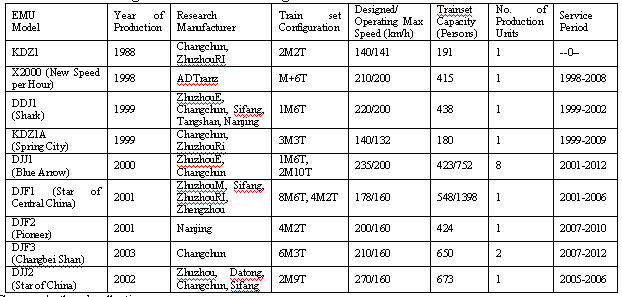
Indigenous EMU prototypes such as ��Shark��, ��Spring City��, ��Blue Arrow��, ��Star of Central China�� and ��Pioneer�� were developed consecutively during the period 1999-2001 (Table 2). However, due to technological deficiencies, most of these EMU prototypes were not moved into mass production. The exception was the DJJ1 Blue Arrow which was regarded as a successful case of the indigenous EMU technological application. The Blue Arrow began its service in December 2000 on the Guangzhou-Shenzhen rail line with a maximum operating speed of 160km/h. In January 2001, the maximum operating speed was elevated to 200km/h, which significantly reduced the travel time between Guangzhou and Shenzhen. In order to achieve a frequent HSR operation, an additional seven units were produced and deployed in October 2001. Source: Authors�� collection.
Following the success of the Blue Arrow, the former MOR planned to develop a more advanced high-speed EMU technology for large scale applications. In early 2000, a proposal called the ��Industrialization Project Report of 270km/h High-Speed Train�� was submitted by the former MOR to the State Planning Commission, one of the highest decision-making agencies in China at that time. The plan was approved. The new EMU prototype, the ��Star of China�� began operations August 18, 2001. The total R&D investment was 130 million RMB including 40 million of financial supports from the central government, 40 million RMB from the former MOR and 50 million RMB from the research consortium. Technologically, the Star of China EMU was similar to the Blue Arrow with a centralized power configuration with 2 powered cars and 9 unpowered cars. The two powered engines were produced by the Zhuzhou Electric Locomotive Manufacturer and the Datong Electric Locomotive Manufacturers. The unpowered cars were jointly produced by the Changchun Locomotive Manufacturer and the Sifang Locomotive Manufacturer. On November 27, 2002, a short version of the Star of China EMU with two powered engines and three unpowered cars watested on the Qinhuangdao-Shenyang Passenger Dedicated Line, and achieved a record speed of 321.5km/h.
Despite of these efforts and successes, indigenous EMU technologies were still regarded as immature and below the foreign technology standards by the top officials of the National Development and Reform Commission (Chen & Wang 2010). Meanwhile, some of the key technologies and equipment still needed to be imported given that the indigenously produces equipment (parts) lacked consistent quality and reliability. Due to these criticisms and concerns, the indigenous EMU technologies were gradually abandoned and the former MOR decided to introduce foreign HSR EMU technology, however, it also required that foreign manufacturers transfer key technologies to China.
Foreign Technology Acquisition
Following Liu Zhijun��s role as the Minister of MOR in 2003, the focus on the development of HSR technology has changed. Railway reform reversed ��the separation of network and operation�� strategy to a ��leapfrog development�� strategy. The new Minister, Liu, was a strong believer in railway development by utilizing foreign technologies. He repeatedly indicated that the process of Chinese Railway development could be accelerated by learning the advanced railway technologies of developed countries in order to achieve a leapfrog development.
On April 1, 2004, the State Council of China held a meeting to discuss the development strategies of railway rolling stock and equipment technologies. A new development principle was adopted to ��introduce advanced technology through joint design and manufacturing, [with an ultimate objective to] to build a Chinese brand�� (Zhang 2006). The principle established a new model for railway technology development and operation, which requires only a small amount of key components to be imported while enabling a large amount of equipment to be produced domestically.
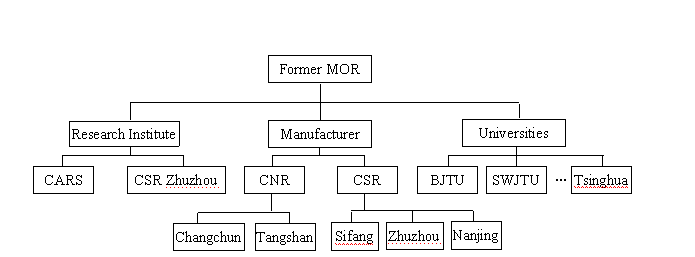
Notes: CNR: China Northern Locomotive & Rolling Stock Corporation
CSR: China South Locomotive & Rolling Stock Corporation
In December 31, the CNR and CSR was announced be merged as combined company named China Railway Rolling Stock Corp, (CRRC), which would become the world��s largest railway rolling stock manufacturer.
Figure 1. Organizational Structure of EMUs R&D and Manufacture in China
In addition, the new development strategy established an integrated R&D organizational structure (Figure 1). Rolling stock manufacturers such as the CSR Sifang Locomotive Co., Ltd., Changchun Railway Vehicles Co., Ltd., Zhuzhou Electric Locomotive Research Institute and the Academy of Railway Sciences as well as other domestic railway research and manufacturing institutions were selected as the major agencies to conduct research, design and manufacturing of the new generation of high-speed EMUs. In addition, railway research related universities such as the Southwest Jiaotong University, the Beijing Jiaotong University and other major institutions were invited to be the leading agencies for imported technology absorption and re-innovation.
Acquisition, Assimilation and Absorption
Under the direction of Liu, MOR had launched three tenders for foreign high-speed EMUs. MOR stipulated that foreign companies had to collaborate with domestic partners in the competition and had to transfer key technologies to achieve localization. Three guidelines were imposed during the procurement solicitation processes. First, key technologies must be transferred to China. Second, the bidding price must be reasonable and third, newly produced EMUs must have a Chinese brand. The first tender was launched in June 2004 with a focus on the bidding for 200 km/h EMUs technologies. The second tender was launched in October 2005, which focused on bidding for 300 km/h EMUs. The third tender was launched in November 2006 with a purpose of procuring EMUs for the first newly-built Beijing-Tianjin Intercity HSR project. An acquisition strategy was applied by the MOR. It divided dozens of domestic rolling stock companies into two groups under the lead of the CSR Sifang and CNR Changchun to negotiate with foreign producers. The MOR made initial market access advantage the inducement to get foreign EMU manufactures including Siemens, Alstom, Bombardier and Kawasaki to reduce their bidding prices.
Table 3 Tenders for EMUs during 2004 and 2006
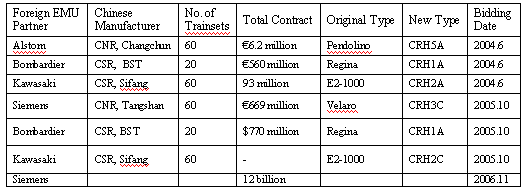
Source: Authors�� collection.��-�� indicates data is not available.
The strategy proved successful as it dramatically reduced the cost of foreign EMUs technology acquisition. During the first tender, Alstom, Bombardier and Kawasaki had all received a share of the orders. Siemens was the exception due to its extraordinarily expensive bidding price for its the ICE technologies. They asked for a cost of $5 billion (35 billion RMB) for 60 train sets and a $5.7 billion for a technology transfer. The loss in the first tender made Siemens adjust its strategies. During the second tender for the 300km/h EMUs, Siemens offered a much lower price of �669 million for 60 trainsets of the ICE-3 Valero (Table 3) and �80 million for the key technology transfer.
Absorption and Incorporation
The national HSR development strategy set various rules for HSR deployment. For example, construction was deployed entirely on indigenous innovation. Communication and power traction system needed to be developed through integration of existing domestic innovations. Operations, scheduling and passenger service systems would be developed based on internal or self-innovation. Rolling stock manufacturing should be implemented through an assimilation of foreign technology and achieving innovation through integration. Localization was regarded as a key measurement for the effectiveness of foreign technology utilization. A higher localization rate were measured by the share of domestically produced components among the assembled final products. Hence, it reflects a program��s capacity to create effect technological assimilation and absorption.
Among the 160 units of the procured 200km/h foreign EMUs after the first tender in 2004, 9 units were produced and assembled by foreign partners. 151 units were produced and assembled domestically, all of which were completed at the end of 2007. The localization rate was 70%. The second procurement ordered 120 units of 300km/h EMUs in 2005, 60 of which were developed domestically by CSR Sifang based on the 200km/h EMU technology that was acquired through the first procurement. All train sets were completed in 2009 and the localization rate increased to 85%. The other 60 units were manufactured by the CNR Tangshan and were based on the acquired technology from Siemens. Only three units were imported whereas 57 units were manufactured domestically. The localization rate was increased from its initial level of 30% to the level of 70% at the end of 2009.
To achieve rolling stock technology assimilation and absorption, the tasks of R&D and manufacturing of the 9 key subsystems including the body of an EMU, bogies, traction control, traction transformers, converters, traction motors, braking systems, network control systems and EMU system integration technology were allocated to various research and manufacturing institutions. For instance, the AC traction system and network control system were primarily researched and manufactured by Zhuzhou Electric Locomotive Research Institute, the Rolling Stock Institute of CARS. The integration and absorption of the braking systems of the foreign EMUs were conducted by the CRS Nanjing Rolling Stock Manufacturer.
Technology Transfer, Transformation and Integration
The experiences of previous indigenous technology R&D as well as the assimilation and absorption of foreign technology have made technology transfer, transformation and integration a reality. Under the organizational structure of the joint venture, the EMU technologies acquired from Japan, France and Germany could be seamlessly transformed into a new generation of Chinese EMUs, which is known as the China Railway High-speed (CRH) series, or ��Hexie Hao�� (meaning Harmony). Specifically, six different types of CRH EMUs have been developed and each type consists of different specifications (Table 4). Below we discuss the result of the technology transfer and how it has led to absorption and assimilation of the foreign technologies and it provides a basis for integration and full transformation leading to indigenous innovation once again. This section outlines how the old technologies were integrated and transformed by innovation leading to a better domestic utilization. This is the basis of the next round of innovation and change but led by China��s own domestic base in the HSR industry.
Table 4 CRH EMU Technological Specifications
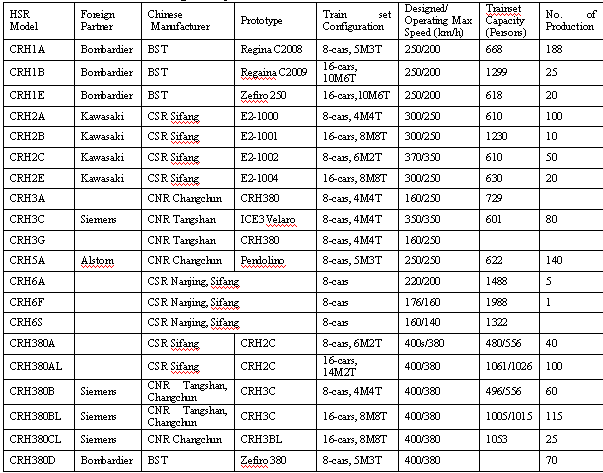
Source: Authors�� collection. Note: A indicates the standard 8-cars configuration, B series or AL represents the 16-cars configuration, and E series refer to the sleeper car configuration.
The CRH1 was built by the joint venture Bombardier-Sifang-Transportation Ltd (BST) based on Bombardier��s Regina family. The CRH1A was developed based on the Swedish Regina C2008, which is an 8-cars configuration with five powered units and three units of trailers. The CRH1B was developed based on the Swedish Regina C2009 and consists of 16 units. The CRH1E was developed based on a newly developed Bombardier prototype Zefiro 250 with a 16-unit configuration. Each train set consists of 10 powered units and 6 unpowered units. Unlike CRH1A and CRH1B that are regular coach trains, the CRH1E is a sleeper train with a maximum capacity of 618 persons. Since the maximum speed of the CRH1 is 250km/h, the units are primarily designed to serve intercity passenger rail within the same province.
The CRH2 was initially jointly developed by the CSR Sifang Ltd and the Japanese Kawasaki Consortium which consists of six enterprises including Kawasaki Heavy Industries, Mitsubishi Corporation, Mitsubishi Electric Corporation, Itochu, Marubeni and Hitachi. The prototype technology is the E2-1000 series Shinkansen and the total cost of technology transfer was 1.29 billion dollars. The CRH2A was the first series of CRH2 to be developed. The basic configuration is four powered units and four unpowered units with a maximum speed limit of 250km/h. A few adjustments were made after the initial technology transfer so as to make the EMU better fit the Chinese rail networks. For instance, the original Japanese pantograph PS207 was replaced by the German Stemman-Technik DSA250. The CRH2B is an extended version of the CRH2 series and consists of 16 units with a maximum transport capacity of 1230 people. The CRH2C is a new CRH2 type which was all elements manufactured domestically. Sifang Ltd has made considerable re-innovation to improve its performance. For instance, the traction system was improved with the adoption of YQ-365 AC power (Cheng 2009). Other technological upgrades include the redesign of the body structure so as to reduce resonance and pneumatic deformation at high speeds, improvement of bogie��s suspension system to reduce resistance and avoid snaking movements. With these technological innovations, the operational performance of the CRH2C has been substantially improved. Furthermore, the innovations have allowed a maximum speed limit to be extended from 250km/h to 350km/h. In addition, the CRH2E has been developed as a sleeper EMU for a long distance passenger transport service based on the CRH2B. The onboard facilities such as intelligent business support equipment, entertainment equipment, passenger calling systems and caf�� bar facilities were added to improve passenger travel experience.
The CRH3 was developed based on the Siemens�� EMU technology. The original type was CRH3C, which was developed and manufactured by the CNR Tangshan Rolling Stock Manufacturer based on Siemens��s ICE-3 Valero prototype. The train set adopts a power decentralized configuration with four powered units and four unpowered units. The CRH3C has a maximum speed of 350km/h. The first three EMUs were manufactured in Germany and were named as CRH3A after their arrival in 2008. However, it was later changed to CRH3C as CRH3A is used for another EMU series. The CRH3C was initially deployed on the Beijing and Tianjin Intercity Passenger HSR line but later operated on other HSR lines such as Beijing-Hong Kong, Hangzhou-Shenzhen and Hengyang-Nanning.
In addition, two lower speed level EMUs, the CRH3A and the CRH3G were developed by the CNR Changchun and the CNR Tangshan respectively in 2013. Unlike the CRH3C, the designs of these two EMUs are derived from the platform of CRH380 EMU. Both are lower-cost designs for use on intercity routes with maximum speeds between 160 and 250 km/h.
The CRH5 was jointly developed by the French Alstom and the CNR Changchun based on the Alstom��s ETR-600 Pendolino EMU. The prototype was a titling train used in Italy, but China��s CRH5 is non-tilting. On October 10, 2004, a contract was signed between Alstom and the MOR at a price of �620 million to manufacture 60 units of EMUs. According to the contract, seven key technologies of the prototype EMU would be transferred to China. Among the 60 units, the initial 3 units were manufactured by Alstom in Italy and were shipped to China. Another six units were assembled by the CNR Changchun with all parts manufactured and shipped from Italy. The remaining 51 units were manufactured by the CNR Changchun through a technology transfer from Alstom. The CRH5A is the only specification for the CRH5 series and it adopts power decentralized design. It has a maximum speed of 250km/h and each train set consists of 8-cars, including four powered units and four unpowered units. The CRH5A is one of the most widely deployed EMUs among the CRH family. In addition to being operating on the main HSR lines, it has also been operated on the Lanzhou- ��r��mqi passenger dedicated line (PDL), which is one of the most challenging lines given its harsh environment including strong wind, sandstorm, high attitude and low temperature.
The CRH6 is a new generation of EMU designed by the CSR Sifang and manufactured by the CSR Nanjing at its subsidiary factory in Guangdong province. The development of the CRH6 was motivated by the intercity passenger rail projects in the Pearl River Delta region centered in Guangdong. It is primarily designed for intercity travel within a provincial boundary as well as for short-distance commute between urban and suburban areas in major metropolitan cities. Three specifications were designed for different purposes. The CRH6A which has a maximum speed of 200km/h, is mainly used for a direct transport service between major cities. The 8-car configuration includes 557 seats with a maximum transport capacity of 1,488 passengers. The CRH6F is designed with a maximum speed of 160km/h and a maximum capacity of 1,988 passengers. Given that its purpose is for a short-distance commute and intercity travel, the CRH6F possesses designs of urban transit systems such as improved braking, wider spacing and middle doors on each side to achieve faster ingress and egress. The CRH6S is another type of EMU for a short-distance intercity travel purpose with a maximum speed of 140km/h.
The CRH380 is a new series of EMU that is designed and manufactured for a high-speed operation at 380km/h. The development of the CRH380 was initially promoted by the Action Plan for the Independent Innovation of Chinese High-Speed Train in 2008. Four types of EMUs were developed by domestic EMU manufacturers through re-innovation based on the transferred foreign technologies. The CRH380A was the earliest type developed in 2010 by the CSR research team and was manufactured by the CSR Sifang. The prototype is the CRH2C and substantial technological innovation was added to improve its operation performance. For instance, these include the exterior shape, reduce air resistance and air tightness, noise reduction for higher speed and new body materials. On December 3, 2010, a CRH380A EMU achieved a record speed of 186.1km/h during a test run on the Beijing-Shanghai HSR line.
The CRH380B is the second type of the CRH380 EMU series. It was based on the CRH3C produced by CNR Tangshan. It has a standard configuration of 8-cars and a longer version with a configuration of 16-cars. Average operation speed was elevated from 300 km/h to 350 km/h. In addition, the operation performance was improved through the optimization of traction power system, aerodynamic shape redesign, noise reduction of noise and onboard pressure control. The CRH380 was deployed on the HSR in the Northern provinces such as the Beijing-Harbin PDL due to its specific design for cold weather. Others were deployed to the main lines such as Wuhan-Guangzhou PDL, Shanghai-Nanjing and Shanghai-Hangzhou.
The CRH380C has been further upgraded and is manufactured by the CNR Changchun. The standard configuration CRH380CL is 16-cars configuration. It adopts a new streamlined head design which reduces air resistance The propulsion system was upgraded to enable high-speed performance. The CRH380D is the fourth type of the EMU in the CRH380 series manufactured by the Bombardier Sifang Transportation Ltd. It was developed based on the Bombardier Zefiro 380 EMU with a top speed at 380km/h.
In addition to the development of EMU technologies, other technologies such as the train control system for HSR have also been developed. For instance, based on a local innovation, the Chinese Train Control System 3 (CTCS-3), which is based on the GSM-R communication technology, was developed by a former MOR research group. The system later was manufactured by the Chinese telecommunication company Huawei Ltd and is currently applied by various Chinese HSR systems.
On April 18, 2007, the Sixth Speed-Up Initiative was implemented among the entire Chinese railway system. Hundreds of newly built EMUs were operated on the existing lines at 200-250 km/h or even higher speeds (at or close to 300 km/h), symbolizing that the Chinese railway system has fully evolved into the era of high-speed.
Conclusion
The effective deployment of Chinese HSR technology clearly has made a great contribution to speed and convenience. While the indigenous EMU technologies were ultimately abandoned for various reasons, the rapid catch up to HSR pioneer countries through the technology acquisition strategy is undoubtedly attributable to the strong R&D capacities that were accumulated from previous experiences as well as through the learning process from foreign technologies. Although the dual roles of the former MOR as both a participant and an organizer in the tendering processes were not favored by the foreign participants, the principle of ��exchanging market for technology �� was effectively implemented and thus increased the competitiveness of the Chinese domestic partners in the negotiation processes and was effective in transferring technology. The result is a new HSR industry in China has emerged which now serves the new vast HSR network and looks externally to export it new skill in HSR production and its new cutting edge activity in HSR innovations.
Notes
Some of the material in the paper is referenced directly from the book by Chen and Haynes (2015) with express permission of the authors and publisher (Emerald). We thank the publisher for their cooperation.
. According to the HSR definition of the International Union of Railways (UIC), a true HSR refers to a system that is capable of maintaining an average speed of over 250 km/h. The construction of the first Chinese HSR began on July 4, 2005, and the service opened on August 1, 2008.
. http://www.ftchinese.com/story/001034854?full=y 10/25/2014
. Ibid.
. http://www.gzzctl.com/word/lj.htm 10/21/2014
. http://news.sina.com.cn/c/163578.html 10/26/2014
. Ibid.
. The former State Planning Agency was a macroeconomic management agency under the Chinese State Council, which had broad administrative and planning control over the Chinese economy. It was renamed the National Development and Reform Commission in 2003.
. http://news.xinhuanet.com/st/2006-03/13/content_4302097_1.htm 10/26/2014
. Ibid.
. Ibid.
. http://www.china.com.cn/chinese/OP-c/413571.htm 10/26/2014
. Interview of the Chinese Academy of Engineering, Sun Yongfu: Government must play a leading role for Technology Introduction, http://paper.people.com.cn/rmrb/html/2007-07/31/content_14137782.htm 10/26/2014
. http://www.railwaygazette.com/news/business/single-view/view/cnr-and-csr-agree-merger-terms.html 3/21/2015
. Ibid.
. Ibid.
. http://news.sina.com.cn/c/2007-06-04/015311950828s.shtml 10/26/2014
. Ibid.
. http://finance.qq.com/a/20120702/004922.htm 11/1/2014
. http://finance.sina.com.cn/chanjing/cyxw/20110814/224910313552.shtml 11/1/2014
. Ibid.
. Ibid.
. The former chief engineer of the Chinese HSR Zhang Shuguang indicated that the new generation of the Chinese EMU is named as ��Hexie Hao��, meaning harmony for three reasons. First, it symbolizes a new transport mode to achieve harmony between humans and nature given its energy-saving and environmental friendly design. Second, it is a product that reflects a harmonious technological integration of over 12,000 mechanical components. Third, it serves as a new transport mode to achieve social harmony, which also echoes the political slogan of ��harmonious society�� raised by the former Chinese President Hu Jintao. The interview of Zhang Shuguang is available at: http://www.china.com.cn/city/txt/2007-04/12/content_8106935.htm 11/ 1/ 2014
. http://www.railwaygazette.com/news/single-view/view/high-speed-trainsets-take-shape.html 11/1/2014
. http://jp.mofcom.gov.cn/aarticle/jmxw/200411/20041100300572.html 11/1/2014
. http://www.zacliu.com/20100419/crh2/ 11/1/2014.
. news.163.com/08/1222/08/4TOL5IAL0001124J.html 11/1/2014
http://www.railwaygazette.com/news/single-view/view/cnr-tangshan-rolls-out-crh3a.html 11/1/2014
. http://www.alstom.com/press-centre/2004/10/ALSTOM-awarded-business-worth-one-billion-euros-by-chinese-railways-20041009 11/2/ 2014
. Ibid.
. http://society.people.com.cn/n/2014/0610/c1008-25130201.html 11/2/2014
. http://njrb.njdaily.cn/njrb/html/2013-05/07/content_63724.htm 11/ 2/2014
. http://www.csrgc.com.cn/g2146/s4909/t251531.aspx 11/ 2/ 2014
. http://www.gov.cn/gzdt/2008-02/29/content_905588.htm 11/ 2/2014
. CNR Changchun, CRC High Speed Train Manufacturing Strength Presentation 5/10/ 2013
. Ibid.
. Ibid.
. http://www.huawei.com/cnapp/198/hw-082959.htm 11/ 2/2014
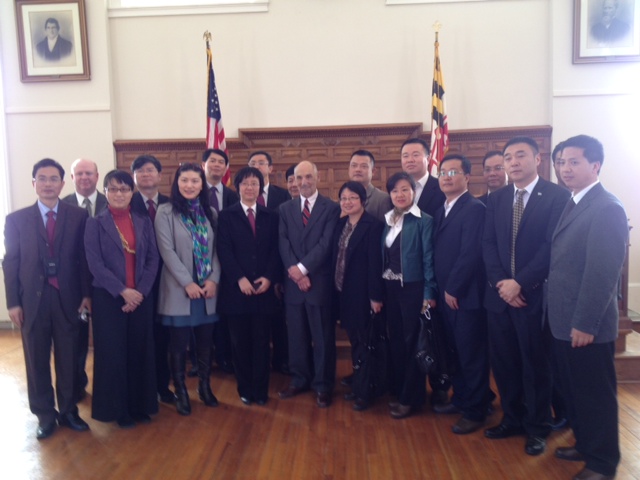 |
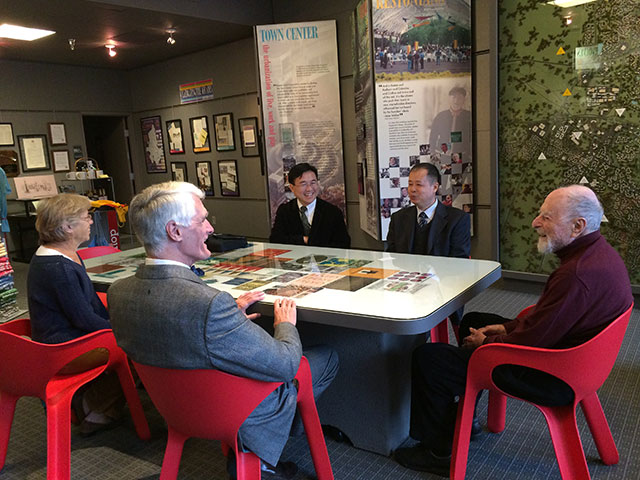 |
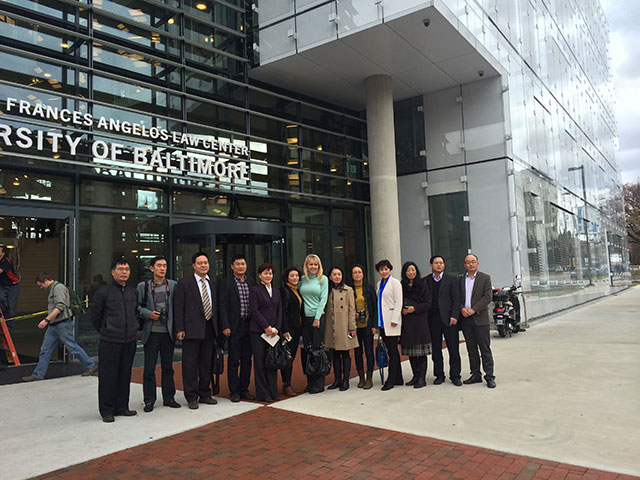 |

